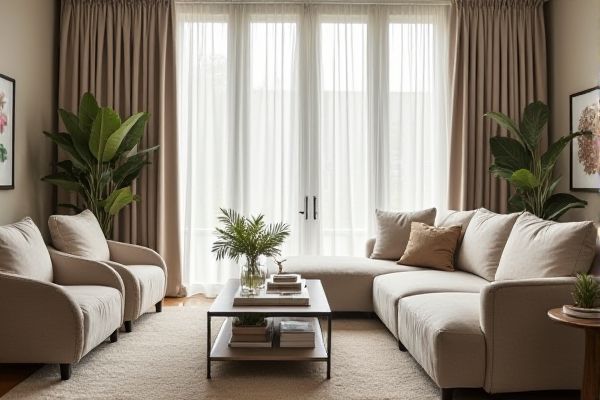
Slipcovers provide a removable, versatile option to protect or refresh your furniture's look, while upholstery offers a more permanent, tailored finish that enhances durability and style. Explore the rest of the article to discover which choice suits your needs and lifestyle best.
Table of Comparison
| Feature | Slipcover | Upholstery |
|---|---|---|
| Definition | Removable fabric cover placed over furniture | Permanent fabric or leather cover attached to furniture |
| Installation | Easy to put on and remove | Requires professional upholstering |
| Customization | Limited styles and fits, often generic | Highly customizable with fabrics and design |
| Maintenance | Machine washable and replaceable | Requires professional cleaning or repair |
| Durability | Prone to wear and tear, less durable | Long-lasting and sturdy material application |
| Cost | Affordable and budget-friendly | Higher upfront investment |
| Use Case | Ideal for temporary protection and style changes | Best for permanent furniture style and comfort |
Introduction: Slipcover vs Upholstery
Slipcovers offer a versatile and removable protection for furniture, allowing easy cleaning and style updates without permanent alteration. Upholstery involves the permanent fabric covering of furniture, providing durability and a tailored finish that enhances the piece's structure and comfort. Choosing between slipcovers and upholstery depends on factors such as maintenance preferences, budget, and desired aesthetic longevity.
What Is Slipcover?
A slipcover is a removable fabric covering designed to protect or change the appearance of furniture, offering a versatile and cost-effective alternative to upholstery. Unlike upholstery, which involves permanently attaching fabric to furniture through stapling or sewing, slipcovers can be easily taken off for cleaning or seasonal updates. You can enhance your living space effortlessly with slipcovers by choosing materials and styles that suit your decor while preserving the original furniture underneath.
What Is Upholstery?
Upholstery refers to the materials and techniques used to cover furniture frames, including fabric, padding, and springs, providing both comfort and aesthetic appeal. Unlike slipcovers, upholstery is permanently attached to the furniture, requiring skilled craftsmanship for repair or replacement. Your choice between slipcover and upholstery depends on whether you prefer durability and a tailored fit or the flexibility of removable covers.
Cost Comparison: Slipcover vs Upholstery
Slipcovers generally offer a cost-effective alternative to upholstery, with prices ranging from $50 to $300 depending on fabric and size, whereas professional upholstery can cost between $500 and $2,000 or more due to labor and material expenses. You can save substantially by choosing slipcovers for seasonal style changes or protection, while upholstery is a long-term investment for enhancing furniture durability and aesthetic. Maintenance and replacement costs also favor slipcovers, as they are easier and cheaper to clean or replace compared to reupholstering furniture.
Durability and Maintenance
Slipcovers offer easy maintenance with machine-washable fabrics that protect underlying furniture from stains and wear, extending the life of upholstery. Upholstery provides greater durability with its permanently fixed fabric designed to withstand daily use, often made from heavy-duty materials like leather or tightly woven textiles. Choosing between slipcover and upholstery depends on whether ease of cleaning or long-term sturdiness is the priority for furniture care.
Style and Design Flexibility
Slipcovers offer exceptional style and design flexibility by allowing you to easily change your furniture's look with different fabrics, patterns, and colors. Upholstery provides a more permanent design choice, often enhancing the original furniture's aesthetic with tailored, high-quality materials that contribute to durability and comfort. Your decision should balance the desire for versatile style updates against the long-term investment in customized, enduring design.
Installation Process and Time
Slipcovers offer a quick and straightforward installation process, often completed within minutes without specialized tools, making them ideal for temporary changes or seasonal updates. Upholstery requires a more complex and time-consuming procedure involving fabric removal, cutting, and precise sewing, which can take several hours or days depending on the furniture piece. If you need a fast and convenient solution, slipcovers save you significant installation time compared to traditional upholstery.
Cleaning and Care Considerations
Slipcovers offer easy cleaning and maintenance since they are removable and machine washable, making them ideal for households with pets or children. Upholstery requires professional cleaning or spot treatment, as most fabric types are fixed and sensitive to harsh chemicals or water exposure. Regular vacuuming and prompt stain treatment are essential for both, but slipcovers provide greater convenience and flexibility in care.
Ideal Uses for Slipcover
Slipcovers are ideal for protecting your furniture from spills, pet hair, and everyday wear, making them perfect for homes with children or pets. They offer a versatile and affordable way to update the look of sofas or chairs without the commitment of permanent upholstery. Slipcovers also simplify cleaning and maintenance, as they can be easily removed and washed, extending the life of your furniture.
Ideal Uses for Upholstery
Upholstery is ideal for creating durable, long-lasting furniture that withstands daily use and maintains its structure and comfort over time. It is perfect for pieces that require a tailored, polished look with fixed fabric, such as sofas, armchairs, and dining chairs. Your choice of upholstery materials can significantly enhance the furniture's aesthetic, durability, and maintenance requirements in high-traffic areas.
 homyna.com
homyna.com